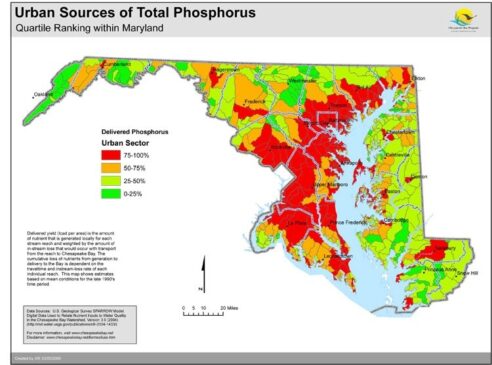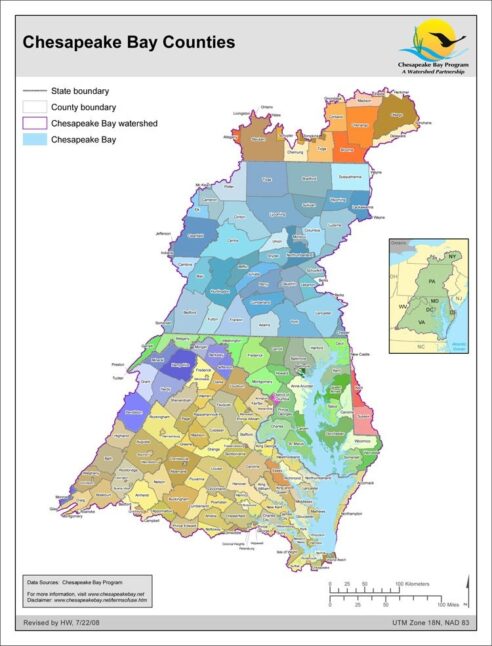Maps
Browse through maps depicting Bay health and restoration, including pollution trends, public access sites and more.
Maryland Tier II Catchments
Date created: February 28, 2013Non- tidal watersheds, under regulatory anti-degradation protection, that exceed minimum applicable water quality criteria and standards. Currently, Tier II streams are identified according to fish and benthic indices of biotic integrity.
View mapStronghold Watersheds- Maryland
Date created: February 27, 2013Small, non-tidal watersheds with the largest population of rare, threatened and endangered aquatic animals.
View mapSentinel Site Watersheds- Maryland
Date created: February 27, 2013Small, healthy non-tidal watersheds that are used for long term monitoring to detect changes from global climate change and from other natural phenomena.
View mapPriority Cold Water Conservation Areas- Maryland
Date created: February 27, 2013Watersheds that support coldwater dependent species.
View mapPriority Anadromous Fisheries Watersheds- Maryland
Date created: February 27, 2013Large Watersheds that provide important spawning and nursery habitat for commercial and recreational anadromous fisheries.
View mapUrban Sources of Total Nitrogen - Quartile Ranking within Maryland
Date created: July 14, 2011This map shows a quartile ranking within Maryland of the delivered yield (load per area) of Total Nitrogen from urban sources. Delivered yield is the amount of nutrient that is generated locally for each stream reach and weighted by the amount of in-stream loss that would occur with transport from the reach to Chesapeake Bay. The cumulative loss of nutrients from generation to delivery to the Bay is dependent on the travel time and instream-loss rate of each individual reach. This map shows estimates of Total Nitrogen based on mean conditions for the late 1990's time period using the SPARROW model from USGS. SPARROW, or SPAtially Referenced Regressions On Watershed (SPARROW) attributes, uses a nonlinear regression approach to spatially relate nutrient sources and watershed characteristics to nutrient loads of streams throughout the Chesapeake Bay watershed.
View mapPoint Sources and Priority Agricultural Watersheds - Maryland
Date created: March 9, 2009This map shows the location of point sources of nutrient pollution and priority agricultural watersheds as identified by the Chesapeake Bay Program with input from the Natural Resources Conservation Service (NRCS). Point sources include both monitored and estimated data submitted from or approved by each jurisdiction. Priority agricultural watersheds include SPARROW catchments ranking in the top quartile for delivered loads of nitrogen or phosphorus from agricultural sources normalized by the total amount of agricultural areas within the catchment. The priority areas were further refined to emphasize high loading areas which also contained potential agriculture-related water quality impairments based on individual state 303d (impaired waters) lists.
View mapUrban Sources of Total Phosphorus - Quartile Ranking within Maryland
Date created: March 5, 2009This map shows a quartile ranking within Maryland of the delivered yield (load per area) of Total Phosphorus from urban sources. Delivered yield is the amount of nutrient that is generated locally for each stream reach and weighted by the amount of in-stream loss that would occur with transport from the reach to Chesapeake Bay. The cumulative loss of nutrients from generation to delivery to the Bay is dependent on the travel time and instream-loss rate of each individual reach. This map shows estimates of Total Phosphorus based on mean conditions for the late 1990's time period using the SPARROW model from USGS. SPARROW, or SPAtially Referenced Regressions On Watershed (SPARROW) attributes, uses a nonlinear regression approach to spatially relate nutrient sources and watershed characteristics to nutrient loads of streams throughout the Chesapeake Bay watershed.
View map
Chesapeake Bay Counties
Date created: July 22, 2008A map showing the counties (and sometimes municipalities) that are entirely or partially within the Chesapeake Bay basin.
View map
